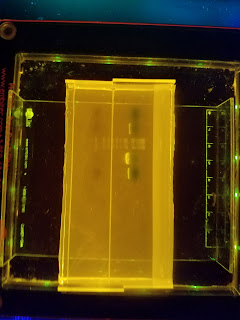Week 1
Yesterday concluded my very first week working as a volunteer researcher at Dr. Yongchang Chang's laboratory at Barrow Neurological Institute!
It was truly fascinating to see (and perform) current research in the neuroscientific field rather than reading about it in a decade-old textbook. I especially enjoyed using the highly specialized equipment that can't be found in any high school lab (and appreciated that he let me use it at all). All in all, I am really looking forward to the remaining nine weeks.
Here is a summary of my daily activities, simplified for readability and confidentiality (this research is not yet published.) As of now, the materials for my specific project have not yet arrived, so I spent this week assisting Dr. Chang with another topic he is currently researching.
On Monday, he explained to me this topic of study: zinc-activated ion channels, which are present in the human brain, spinal chord, lungs, kidneys, and many other regions. Very little is known about their function and activation, which he hopes to change.
We went down to the vivarium and picked up the frog whose egg cells we would be expressing the ion channels in. He sedated and performed the procedure on the frog, which he then stitched back up and returned.
Afterwards, we used a microinjector to deliver the ion channel DNA into the tiny egg cells.
It was truly fascinating to see (and perform) current research in the neuroscientific field rather than reading about it in a decade-old textbook. I especially enjoyed using the highly specialized equipment that can't be found in any high school lab (and appreciated that he let me use it at all). All in all, I am really looking forward to the remaining nine weeks.
Here is a summary of my daily activities, simplified for readability and confidentiality (this research is not yet published.) As of now, the materials for my specific project have not yet arrived, so I spent this week assisting Dr. Chang with another topic he is currently researching.
On Monday, he explained to me this topic of study: zinc-activated ion channels, which are present in the human brain, spinal chord, lungs, kidneys, and many other regions. Very little is known about their function and activation, which he hopes to change.
We went down to the vivarium and picked up the frog whose egg cells we would be expressing the ion channels in. He sedated and performed the procedure on the frog, which he then stitched back up and returned.
Afterwards, we used a microinjector to deliver the ion channel DNA into the tiny egg cells.
The microinjector and egg cells.
What it looks like from the lens (needle in egg cell)
The cells were put in the fridge overnight so they could express the DNA.
On Wednesday, we prepared solutions of the various chemicals with which we would be assessing the ion channel function. We then began using the voltage clamp, an instrument that measures minute (on the nanoampere level) electrophysiological changes in a cell due to receptor activation/inhibition.
The cell is placed in this miniscule holder (screws are actual size):
Essentially, we bathed it in the different solutions that we prepared and stuck it with microscopic electrodes to measure the electrical response to those chemicals.
On Thursday and Friday, I conducted multiple trials of the same procedure with varying concentrations of the chemicals. It was not easy-- both the egg cells and the electrode tips are extremely fragile, and I often found myself damaging both and having to replace them (which, thankfully, are expendable).
In between, Dr. Chang explained to me in further detail the process of designing and ordering DNA plasmids (for my project) and discussed possibly inducing some mutations in the ion channels and assessing the effect, using an amazing 3D protein model viewer to explore the possibility.
Thanks for reading!





Comments
Post a Comment